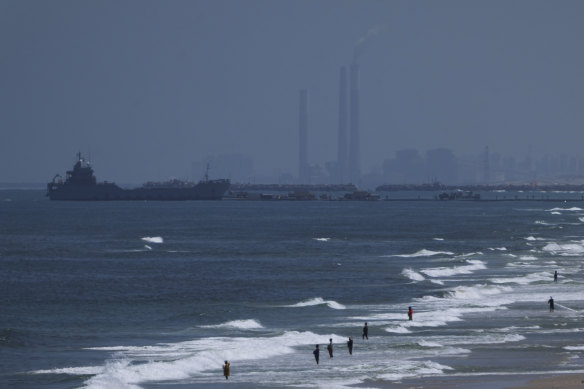
The WFP said on Friday evening that aid had that come through the pier had been transported to its warehouses in Deir al-Balah and was ready for collection and distribution.
Britain said some of its aid for Gaza was in the first shipment that went ashore, including the first of 8400 kits to provide temporary shelter made of plastic sheeting. And it said more aid, including 2000 additional shelter kits, 900 tents, five forklift trucks and 9200 hygiene kits will follow in the coming weeks.
“This is the culmination of a Herculean joint international effort,” said Prime Minister Rishi Sunak. “We know the maritime route is not the only answer. We need to see more land routes open, including via the Rafah crossing, to ensure much more aid gets safely to civilians in desperate need of help.”
The UN humanitarian aid co-ordinating agency said the start of the operation was welcome but not a replacement for deliveries by land.
“I think everyone in the operation has said it: Any and all aid into Gaza is welcome by any route,” Jens Laerke, spokesman of the Office for the Coordination of Humanitarian Affairs, told journalists in Geneva on Friday. Getting aid to people in Gaza “cannot and should not depend on a floating dock far from where needs are most acute.”
Anastasia Moran, an associate director of the International Rescue Committee, argues that the pier is in fact diverting attention from the surging humanitarian crisis.

A ship is seen off the coast of Gaza near the US-built floating pier.Credit: AP
Over the past couple of months, “the maritime route has been taking time and energy and resources at a time when aid has not been scaled up,” she said. “And now that the maritime route is up and running, the land crossings have been effectively shut down.”
During the nine days between May 6, when Israel began the Rafah offensive, and May 15, a total of 154 trucks carrying food and 156 carrying flour have entered Gaza through three land crossings, UN deputy spokesperson Farhan Haq said on Friday. Haq also warned this week that almost no fuel is getting through.
Israel fears Hamas will use fuel in the war, but it asserts it places no limits on the entry of humanitarian aid and blames the UN for delays in distributing goods entering Gaza. Under pressure from the US, Israel has opened a pair of crossings to deliver aid into the territory’s hard-hit north in recent weeks.
Loading
It has said that a series of Hamas attacks on the main crossing, Kerem Shalom, have disrupted the flow of goods. The UN says fighting, Israeli fire and chaotic security conditions have hindered delivery. There have also been violent protests by Israelis that disrupted aid shipments.
Israel recently seized the Rafah border crossing in its push against Hamas around that city on the Egyptian border, raising fears about civilians’ safety while also cutting off the main entry for aid into the Gaza Strip.
US President Joe Biden ordered the pier project, expected to cost $US320 million ($477 million). The boatloads of aid will be deposited at a port facility built by the Israelis just southwest of Gaza City. The US has closely co-ordinated with Israel on how to protect the ships and personnel working on the beach.
Concern about the safety of aid workers was highlighted last month when an Israeli strike killed seven relief workers from World Central Kitchen whose trip had been co-ordinated with Israeli officials. The group had also brought aid in by sea.
Pentagon officials have made it clear that security conditions will be monitored closely and could prompt a shutdown of the maritime route, even if just temporarily. Already, the site has been targeted by mortar fire during its construction, and Hamas has threatened to target any foreign forces who “occupy” the Gaza Strip.
Israeli forces are in charge of security on shore, but there are also two US Navy warships nearby that can protect US troops and others.
The aid for the sea route is collected and inspected in Cyprus, then loaded onto ships and taken about 320 kilometres to the large floating pier off the Gaza coast. There, the pallets are transferred onto the trucks that then drive onto the army boats, which will shuttle the trucks from the pier to a floating causeway anchored to the beach. Once the trucks drop off the aid, they return to the boats.
AP



























